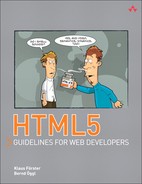Preface
In 2010, HTML5 became the buzzword on the web developer scene. Large companies, such as Google, Apple, and Microsoft, began to use the new technology. The popularity of the catchword HTML5 grew, not least of all because of the heated debate between Apple and Adobe over whether this would mean the end of Flash.
In this book, we give you extensive insight into the new possibilities of HTML5. In addition to the classic specification components, such as video, audio, canvas, intelligent forms, offline applications, and microdata (to name but a few), this overview also includes topics in the immediate context of HTML5—for example, geolocation, web storage, WebSockets, and web workers.
Numerous compact, clear, and practical examples illustrate the new elements and techniques in HTML5. There is something here for everyone, whether you decide you want to construct a web log, program your own video and audio player, use the browser as a graphics program, work with geographical data, test to the limit the capacity of your browser, or prefer to live out your playful nature by trying a quiz with drag and drop or playing Battleships! with WebSockets. We also give you plenty of tips and tricks regarding JavaScript and the DOM.
It is to be expected that sooner or later all browsers, in order to remain competitive in the future, will accommodate HTML5. We therefore decided not to include workarounds and compatibility libraries in most cases. In this book you will find pure HTML5, supported in our examples by at least one browser, but in most cases supported already by several manufacturers. For an up-to-date and complete reference of the new HTML elements, we refer you to the Internet. You will find the relevant links in the appropriate text passages of this book.
How to Read This Book
How you decide to explore this book is entirely up to you. The individual chapters do not necessarily have to be read consecutively and are designed to be easily understandable, even if you have not yet read the other chapters. So, you can read the book in the traditional way, from front to back; alternatively, you can read it from back to front or in any order, letting your curiosity guide you.
Who This Book Is for
You should definitely have a basic knowledge of HTML, JavaScript, and CSS; a willingness to work with a different browser for a change, not just the one you are used to; and above all, a desire to discover something new. Try new ideas, such as those in this book, or have a look at the companion website where you can see all the examples in color. Decide what you want to do and, most important, have fun!
The companion website can be found at http://html5.komplett.cc/welcome.
